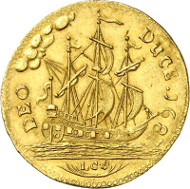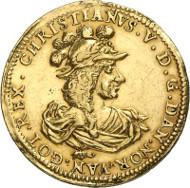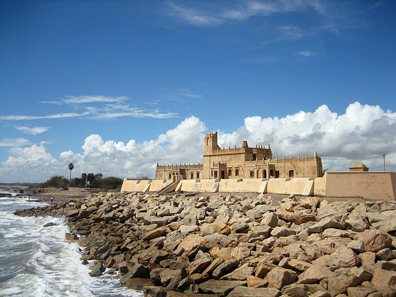Numismatic witnesses to Denmark’s colonial past
Black and white gold, ivory and slaves – such were the goods the foreign powers sought in Africa. In addition, the African gold mines were nothing to sneeze at, too! The business between European merchants and local rulers was a lucrative one and it brought not only profit to the Europeans but also benefit for the African aristocracy. They organized the provision of slaves and, in return, gained everything they required to maintain their power: armor and metal. So, cooperation was the means of choice. The foreigners built small coastal trading posts. The local people brought their goods to these collecting points for exchange.
Diagram of a slave ship from the Atlantic slave trade, 1790/1791. Source: Wikicommons.
Africa – the Gold Coast of Guinea, in particular – became an important station of the so-called triangular trade: European ships sailed for Africa, carrying firearms, metal, cloth and glass beads as exchange for slaves. The slaves were transported into the Caribbean afterwards – under appalling conditions. Many of them died but that made the ‘merchandise’ even more precious. The plantation owners in the Caribbean were in constant demand of fresh workers. They paid lavishly for that with the goods they produced: sugar, rum, tobacco and cotton, for which, in turn, there was a good market that yielded noticeable profit. The business was so lucrative that many nations took part in it. The first ones that spring to mind of course are the British, the Dutch and the French, but less significant rulers with great ambitions likewise invested in the triangular trade.
One of them – and this is not widely known in Germany – was Frederick William, Great Elector of Brandenburg. He had founded a trading post in Guinea in 1682. It was called Groß Friedrichsburg, after the ruler, and its garrison housed some 90 Europeans. Frederick William himself headed the African Company which conducted the triangular trade in his interest. In order to optimize the sale of African slaves in the Caribbean, the Prussians cooperated closely with the Danish who even let a small part of their Antilles island St. Thomas to them.
33: Brandenburg-Prussia. Frederick William, 1640-1688. Ducat 1687, Berlin. Friedberg 2231. From auction sale Künker 244 (6th February 2014), 33 (extremely fine to FDC; estimate: 20,000 euros).
One of the coins offered for sale in Künker auction no. 244 bears witness to the Great Elector’s involvement. Its obverse shows the ruler wearing a baroque suit of armor and a long curly wig, holding the baton in the hand. The reverse depicts a ship sailing. The inscription reads DEO DUCE – With God as Leader. God’s influence becomes apparent in the little head blowing favorable wind into the ship’s sails. The gold this ducat was made of comes from Guinea which is why numismatists refers to this type of coin as shipducat or Guinea ducat.
The Great Elector’s successors supported the involvement in Africa only half-heartedly. The lack of sufficient means resulted in economic demise. Frederick I declared the colony insolvent in 1711 and sold it to the Dutch in 1717 for 7,200 ducats and 12 slaves.
The Danish, in contrast, were much more successful with their engagement. In the 1660s, they had built a post at the seaside of modern Ghana which they named Christiansborg after their king Christian V. It became the capital of what is called the Danish Gold Coast.
415: Denmark. Christian V, 1670-1699. 2 ducats 1688, Copenhagen. Friedberg 167. From auction sale Künker 244 (6th February 2014), 415 (about extremely fine; estimate: 15,000 euros).
This fort, and the famous Dannebrog above, is shown on the reverse of a magnificent 2 ducat piece from 1688, which was made of gold coming from Guinea. Just like the Prussian Guinea ducat, this coin is a testimony to king and trade being closely intertwined. On 11th March 1671, Christian V had granted the West India-Guinea Company a privilege that authorized it to carry on commerce in the Caribbean and in Africa. That, however, wasn’t all: the royal navy protected the merchant fleet against the attacks of foreign privateers.
416: Denmark. Frederick IV, 1699-1730. 5 ducats 1704, Copenhagen. Friedberg 246. From auction sale Künker 244 (6th February 2014), 416 (extremely fine; estimate: 75,000 euros).
About 20 years later, Frederick IV had the 5 ducat piece minted from gold from the Danish Gold Coast that likewise will come to auction in the upcoming Künker auction sale. Its reverse depicts a proud ship with gun ports open sailing towards the rising sun. On coins, this direction always stands for hope and future. The exact place where the king located these two is specified in the exergue: CHRISTIANSBORG, i.e. the African trading post as guarantee for future prosperity. The inscription on the reverse takes the same line: CONANDO INVENIMUS, which translates as ‘Daring We Win’.
Guinea was just one part of the Danish trade empire. Particularly important was Danish West Indies, the post in the Caribbean where the slaves that had been bought in Africa were traded again. While these two areas were controlled by the West India-Guinea Company, the Danish East India Company made sure that Asia’s treasures flowed to Europe and that Copenhagen became a hub for Asiatic goods such as spices, tea and silk. Today it is hard to imagine that Danish merchants brought more tea to Europe during the 17th century than the British competitors. Admittedly, England continued to be in the first when it came to consuming the tea: 90 % of the Danish imports were immediately smuggled into England.
Fort Dansborg in Tranquebar, now Tharangambadi, in Tamil Nadu. Photograph: Eagersnap / http://creativecommons.org/licenses/by-sa/3.0/deed.en
The most important seaport of the East India Company was Tranquebar from where the ships embarked on their trips to India, China and the Spice Islands. The Danish owned a small group of islands which they called New Denmark and which we today know as Nicobar Islands.
The Danish minted many coins solely for the trade in Asia. Tranquebar even had its own mint. Probably the most attractive type of coin of the ones produced for foreign business, however, was manufactured in Copenhagen. It was designed specifically for the trade with China where the money changers liked the Spanish 8 reales pieces best – and with good reason. Their constant fineness of 935/100 almost perfectly matched the Chinese wenyin standard of 937/1000.
419: Denmark. Christian VII, 1766-1808. Piaster 1771 (minted in 1774), Copenhagen. Dav. 411. Extremely fine to FDC. Estimate: 80,000 euros.
That was why the Danish die cutters adopted the most important iconographic details of the Spanish pillar dollars and adjusted them to suit Danish conditions. On the obverse, the Danish coat of arms was depicted – instead of the Spanish one. The inscription stated the Danish king together with his titles. The coin’s reverse showed the famous Pillars of Hercules as well as the motto PLUS ULTRA – ‘Further Beyond’.
While the Spanish model exhibited only two globes with a mountain in between, the Danish variant presented parts of the coat of arms again as well as the following inscriptions at the mountain: ISLAND – GRONLAND – FERÖ, hence the first three colonies of Denmark, thanks to which the Danish could refer to themselves as one of oldest colonial powers of Europe: they became subject to Danish control in 1380.
In 1771, only 543 piasters were produced for testing purposes. It seems that the coins met the approval at first, for in 1774 there were 44,900 piasters minted using the dies from 1771. In May 1777, there was a second edition issued, with the mintage of 50,000 specimens, this time using newly cut dies. Contemporary sources, however, report that such big amounts were placed only with difficulties because the Chinese thought the pieces to be too light.
When the British commitment in Africa, China and India grew larger and larger little Denmark was no longer able to compete. In 1845, it sold its harbor Tranquebar to England, and, in 1850, it left Christiansborg for 10,000 pounds likewise to the British. Step-by-step Denmark abandoned most of its harbors and trading posts.
The last Danish oversea colony was Danish West Indies which included the Virgin Islands, Sankt Thomas, Sankt Jan and Sankt Croix. Thanks to its production of sugar it continued to be profitable even after the slave traffic was abolished in Denmark on 1st January 1803. A gold coin featuring the portrait of Christian IX alludes to this profitability.
421: Danish West Indies. Christian IX, 1863-1906. 50 francs (10 daler) 1904, Copenhagen. Friedberg 1. From auction sale Künker 244 (6th February 2014), 421 (extremely fine; estimate: 4,000 euros).
The obverse of the specimen depicts a woman with attributes that were considered characteristic of wild America: a necklace consisting of animal teeth plus upper arm bangles. The personification is shown sitting, holding a rudder between a loaded ship and the products of Danish West Indies: coconuts and sugar canes.
In the early 20th century, however, the plantations fell victim to severe weather and drought. The tax revenues slumped and bore no relationship to the expenses. Hence, the Danish government tried to sell the cost factor colony for 5 million dollars to the USA. But the House of Lords objected and so the transaction failed.
It was left to WWI to make abundantly clear that Denmark simply wasn’t able to govern its Caribbean colony. Negotiations with the USA were resumed – much to the disgust of the Danish nationalists who thought it reprehensible to surrender this last testimony to the former Danish major power. In order to cover its back, the government held the very first plebiscite in Danish history with the result that the majority of the Danish citizens voted in favor of the sale. On 1st April 1917, Denmark left Danish West Indies to the USA for 25 million dollars.
However, it wasn’t until 5th June 1953 that the Danish colonial history came to an end when Greenland as the last colony became part of Denmark on equal footing.
If you want to have a look at the Künker auction catalogue, please click here.
And here you will find all Danish coins in the Künker catalogue.




















